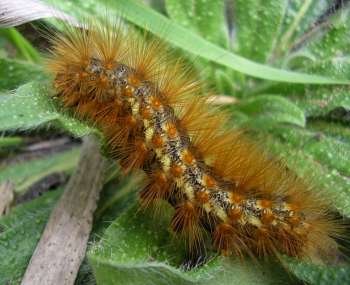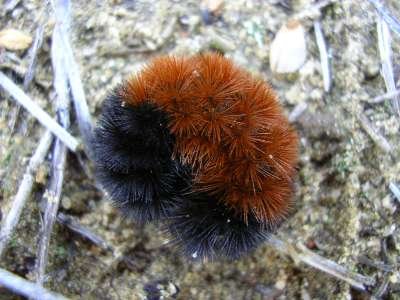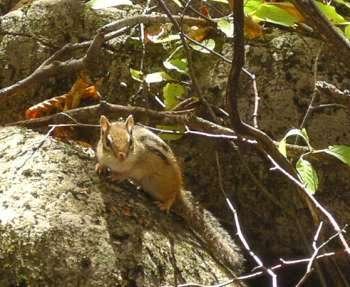After a rainy Saturday, Sunday came bright and windy. Windy, especially after the leaves start to fall is about the least favourable condition for checking out birds. It's hard to see them among all the other movement, and very hard to hear them, or locate sounds that you do hear.
Nevertheless, since I could feel the migrating birds all around me, I headed out to see what I could see. Across the street from the house there was a flicker, as there has been almost every day lately, at the top of a dead tree. Blue jays were calling, and crows were cawing in the hamlet. Interesting about the crows, once the breeding is over they seem to move off somewhere, then either they return, or another family-or-two-sized murder of crows moves in. Lately they've been scarce, until this past weekend.
 Virginia Tiger Moth Caterpillar, I believe.
Virginia Tiger Moth Caterpillar, I believe.Once I got out into the scrape I found this caterpillar. I've been seeing lots of these in the past few weeks. This one is on
viper's bugloss, just like the one that was the subject of a post from this time last year,
Tiger Moth Caterpillar?The scrape was not scraped for topsoil this year (the activity for which I've named the area), nor was the pile created last year taken, and the crop of various colonizers is fantastic, providing lots of seeds for the taking. The main takers are sparrows and Mourning Doves. Mourning Doves flush so noisily and distinctively there's no problem knowing them. Not so with the sparrows. Over the past few weeks, when I can catch a glimpse, I've seen flocks of Chipping Sparrows, Vesper Sparrows, Song Sparrows, and on this occasion Field Sparrows. But often I can't identify them, as I walk they fly up from the weeds fast and fly quickly to a better spot down into the weeds again. There are a couple of small trees, but even when they take shelter (from me) in them I can't always get a fix on them.
Carrying on, without much hope of finding much more, I entered the far field and wandered up to the old apple tree. Surrounded by a thicket of
prickly ash and other shrubbery, this is a good location for warblers, sparrows, and many others. Nobody was there, but I did find a couple of beautiful mushrooms.

After a very dry end to summer, dry enough to curl the leaves of lots of trees and send them into an early fall, we've had a pretty wet few weeks. Everything not set too far back is green again, and there are mushrooms everywhere.
The wind was blowing pretty hard and I remembered all the living poplars I've seen snapped in two by wind (while long-dead elms stay standing) as I walked past stands of them. Once again nothing big came down while I was out there. A single Turkey Vulture flew overhead, going south, more or less. The flyway over Thomasburg in the fall for most flocks usually goes from the northeast to southwest, sometimes almost east to west. More flickers were calling around the edges of the far field. I headed south along the far edge and finally found the kind of commotion I was looking for. More Field Sparrows, some possible others, and an Eastern Towhee (
Pipilo erythrophthalmus). It was the exact spot where I've seen a fall towhee in previous years. It's not where the breeding pair hang out, though not far away. The spot looks like the shrubby edge habitat the runs along the edge of the far field--but if you wanted to see a towhee in September that's where I'd send you. Must be something particularly lovely about it that I just can't see.
Making my way back, taking note of the leopard frog and the lovely giant dragonflies (none of which would settle for me to take a look--I was amazed that they could fly at all in that wind), I crossed the south end of the scrape again, and flushed something out of the weeds growing on a topsoil pile. Sparrow, I assumed, and raised the glasses to see if I could see which one.
Not a sparrow. Not a sparrow at all. I managed to get a few good looks as the bird balanced on a stalk, then flew into a nearby tree. A vireo! What the heck was a vireo doing out here, in the open, in the grasses and weeds? And which one was it? Some yellow underneath, no fancy eye ring. There was a pale eyebrow though, more distinct than the warbling vireo's. After I got back to the house I studied the vireos and decided that this was probably a
Philadelphia Vireo (
Vireo philadelphicus).
Another bird, like the
Scarlet Tanager of last week, completely out of its normal habitat. These are the strange pleasures of fall migration birding.










































